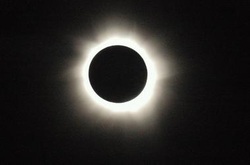The Nature of Light
Michelle Ross

They watch the planetarium’s projection
screen as the moon drifts silently over the
proud eye of the sun, momentarily effacing
its glory. She tells her two-year-old that the sun and moon are playing peekaboo.
Later, in the throng of people exiting, her husband is huddled so close that from her arms their son manages to press a hand behind each of their heads and push until they are cheek-to-cheek, then eye-to-eye.
“Mama and Daddy an ee-lipse,” he says.
“Haha!” they both say uncomfortably.
“Pretend!” their son demands.
“Who is eclipsing whom?” she asks. Her husband starts to open his mouth, but with her one free eye she gives him a look.
“No!” their son says. “Pretend you one ee-lipse.”
Their son is interested in their proximity, not in who is obliterating whom.
What she thinks about on their walk home as the sun wanders off, leaving the moon hovering blindly now like an iris faded by cataract, is how the light illuminating this scene is over eight minutes old. If the sun were to be extinguished for real, no one would know it until eight minutes after. She and her husband and son could be strolling along a downtown sidewalk just like this one. In eight minutes, they could place every animal their son knows onto Old McDonald’s farm.
But eight minutes is nothing. The light from the second-nearest star, Proxima Centauri, is 4.2 years old. The light from the Orion nebula, the belt buckle of the only constellation her husband can identify—over 1,300 years old. The most distant light humans can see with the naked eye—two and a half million years old. For all anyone knew, the Andromeda galaxy could have been burned out long before humans gave a name to it.
When did they stop going out to the lake? In those early years , they used to chase each other up and down the slopes between the trees. Every day was a series of hot, hungry breaths. The way she remembers it, only sleep could knock them loose.
Now the mundane routine of sleeping side by side often seems all that clings.
All those congenial eyes in the sky winking down at them, they’re not what they seem. They’re snapshots in an album, telling a story of what was.
She read somewhere once that couples who display photographs of themselves together throughout their homes are more likely to remain together. The light from what was can sustain love, it seems, keep it generating. Of course, it’s also true that relationships can drag on mirthlessly, scraping by off travel-weary light from love that expired long ago.
You wouldn’t think it could be impossible to know whether the source of a light still exists. You wouldn’t think one could search day after day and come up with so much contradictory evidence. Light is murky.
If theirs is no longer breathing, how long until they will see it with our own eyes? Until they see the light snuffed out.
